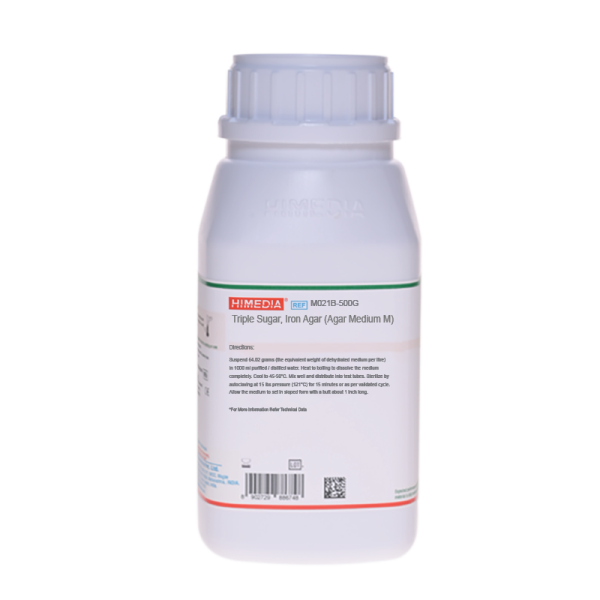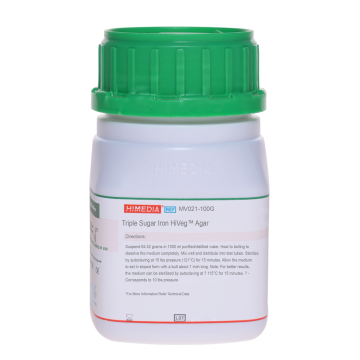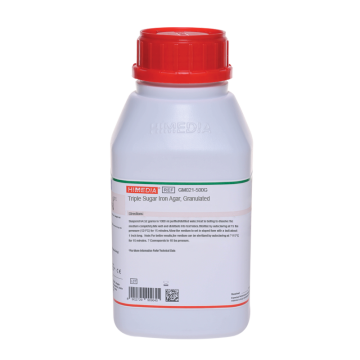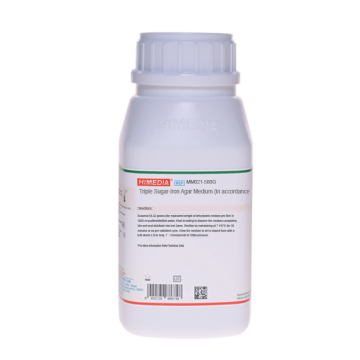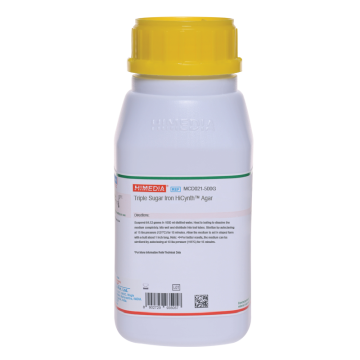 Your enquiry has been submitted
Your enquiry has been submitted
Agar Medium M (Triple Sugar, Iron Agar)
Intended Use:
Recommended for the identification and differentiation of gram-negative enteric bacilli on basis of glucose, lactose and sucrose fermentation and hydrogen sulphide production in accordance with British Pharmacopoeia.
Composition**
| Ingredients | Gms / Litre |
|---|---|
| HMC Peptones # | 20.000 |
| Yeast extract | 3.000 |
| HM Peptone B ## | 3.000 |
| Lactose monohydrate | 10.000 |
| Sucrose | 10.000 |
| Glucose monohydrate | 1.000 |
| Sodium chloride | 5.000 |
| Ferric ammonium citrate | 0.300 |
| Sodium thiosulphate | 0.300 |
| Phenol red | 0.025 |
| Agar | 12.000 |
pH after sterilization (at 25°C) 7.4±0.2
**Formula adjusted, standardized to suit performance parameters
Key: #- Equivalent to Peptone (meat or casein); ## - Equivalent to Beef extract
Directions
Suspend 64.02 grams (equivalent weight of dehydrated medium per litre) in 1000 ml purified /distilled water. Heat to boiling for 1 minute with shaking to dissolve the medium completely. Mix well and distribute into test tubes. Sterilize by autoclaving at 15 lbs pressure (121°C) for 15 minutes. Allow the medium to set in sloped form with a butt about 1 inch long. Note: For better results, the medium can be sterilized by autoclaving at 10 lbs pressure (115°C) for 15 minutes.
Principle And Interpretation
Triple Sugar Iron Agar cited as Agar Medium M, is recommended for identification and differentiation of Enterobacteria by British Pharmacopoeia.(2)
It was originally proposed by Sulkin and Willett (9) and modified by Hajna (4) for identifying Enterobacteriaceae. This medium complies with the composition as specified in British Pharmacopoeia. (2) It can also be used for the examination of meat and food products (8), for the examination of milk and dairy products (10) and for microbial limit test for confirming the presence of Salmonella (1,3) and in the identification of gram-negative bacilli (1, 7).
HMC peptones, yeast extract and HM peptone B provide nitrogenous and carbonaceous compounds, sulphur, trace elements and vitamin B complex etc. Sodium chloride maintains osmotic equilibrium. Lactose, sucrose and dextrose are the fermentable carbohydrates. Sodium thiosulphate and ferrous ions make H2S indicator system. Phenol red is the pH indicator. Organisms that ferment glucose produce a variety of acids, turning the colour of the medium from red to yellow. More amount of acids are liberated in butt (fermentation) than in the slant (respiration). Growing bacteria also form alkaline products from the oxidative decarboxylation of peptone and these alkaline products neutralize the large amounts of acid present in the butt. Thus the appearance of an alkaline (red) slant and an acid (yellow) butt after incubation indicates that the organism is a glucose fermenter but is unable to ferment lactose and/or sucrose. Bacteria that ferment lactose or sucrose (or both), in addition to glucose, produce large amounts of acid enables no reversion of pH in that region and thus bacteria exhibit an acid slant and acid butt. Gas production (CO2) is detected by the presence of cracks or bubbles in the medium, when the accumulated gas escapes. Thiosulphate is reduced to hydrogen sulphide by several species of bacteria and H2S combines with ferric ions of ferric salts to produce the insoluble black precipitate of ferrous sulphide. Reduction of thiosulphate proceeds only in an acid environment and blackening usually occurs in the butt of the tube. Triple Sugar Iron Agar should be used in parallel with Urea Agar/ Broth (M112/M111) to distinguish between Salmonella and Proteus species. The reactions can be summarized as follows:
Alkaline slant / acid butt-only glucose fermented
Acid slant / acid butt-glucose and sucrose fermented or glucose and lactose fermented or all the three sugars, glucose, lactose and sucrose fermented.
Bubbles or cracks present-gas production
Black precipitate present-H2S gas production
Type of specimen
Pharmaceutical samples, Pure bacterial isolate from water, food.
Specimen Collection and Handling:
For pharmaceutical samples, follow appropriate techniques for sample collection and processing as per guidelines (2). For food and dairy samples, follow appropriate techniques for sample collection and processing as per guidelines (8,10). For water samples, follow appropriate techniques for sample collection, processing as per guidelines and local standards.(1) After use, contaminated materials must be sterilized by autoclaving before discarding.
Warning and Precautions
Read the label before opening the container. Wear protective gloves/protective clothing/eye protection/ face protection. Follow good microbiological lab practices while handling specimens and culture. Standard precautions as per established guidelines should be followed while handling specimens. Safety guidelines may be referred in individual safety data sheets.
Limitations :
- Some members of the Enterobacteriaceae and H2S producing Salmonella may not be H2S positive on TSI Agar. Some bacteria may show H2S production on Kligler Iron Agar but not on TSI Agar. This can happen because utilization of sucrose in TSI Agar suppresses the enzymic pathway that result in H2S production.
Performance and Evaluation
Performance of the medium is expected when used as per the direction on the label within the expiry period when stored at recommended temperature.
Quality Control
Appearance Light yellow to pink homogeneous free flowing powder
Gelling Firm, comparable with 1.2% Agar gel.
Colour and Clarity of prepared medium Pinkish red coloured clear to slightly opalescent gel forms in tubes as slants.
Reaction After sterilization, reaction of 6.40%w/v aqueous solution. pH: 7.4±0.2
pH 7.20-7.60
Cultural Response
Cultural characteristics observed after an incubation at 35-37°C for 18-24 hours.
| Organism | Inoculum (CFU) | Growth | Slant | Butt | Gas | H2S |
|---|---|---|---|---|---|---|
| Citrobacter freundii ATCC 8090 | 50-100 | luxuriant | acidic reaction, yellowing of the medium | acidic reaction, yellowing of the medium | positive reaction | positive, blackening of medium |
| # Klebsiella aerogenes ATCC 13048 (00175*) | 50-100 | luxuriant | acidic reaction, yellowing of the medium | acidic reaction, yellowing of the medium | positive reaction | negative, no blackening of medium |
| Escherichia coli ATCC 25922 (00013*) | 50-100 | luxuriant | acidic reaction, yellowing of the medium | acidic reaction, yellowing of the medium | positive reaction | negative, no blackening of medium |
| Klebsiella pneumoniae ATCC 13883 (00097*) | 50-100 | luxuriant | acidic reaction, yellowing of the medium | acidic reaction, yellowing of the medium | positive reaction | negative, no blackening of medium |
| Proteus vulgaris ATCC 13315 | 50-100 | luxuriant | alkaline reaction, red colour of the medium | acidic reaction, yellowing of the medium | negative reaction | positive, blackening of medium |
| Salmonella Paratyphi A ATCC 9150 | 50-100 | luxuriant | alkaline reaction, red colour of the medium | acidic reaction, yellowing of the medium | positive reaction | negative, no blackening of medium |
| Salmonella Typhi ATCC 6539 | 50-100 | luxuriant | alkaline reaction, red colour of the medium | acidic reaction, yellowing of the medium | negative reaction | positive, blackening of medium |
| Salmonella Typhimurium ATCC 14028 (00031*) | 50-100 | luxuriant | alkaline reaction, red colour of the medium | acidic reaction, yellowing of the medium | positive reaction | positive, blackening of medium |
| Shigella flexneri ATCC 12022 (00126*) | 50-100 | luxuriant | alkaline reaction, red colour of the medium | acidic reaction, yellowing of the medium | negative reaction | negative, no blackening of medium |
| Escherichia coli ATCC 8739 (00012*) | 50-100 | luxuriant | acidic reaction, yellowing of the medium | acidic reaction, yellowing of the medium | positive reaction | negative, no blackening of medium |
| Escherichia coli NCTC 9002 | 50-100 | luxuriant | acidic reaction, yellowing of the medium | acidic reaction, yellowing of the medium | positive reaction | negative, no blackening of medium |
| Klebsiella pneumoniae ATCC 10031 | 50-100 | luxuriant | acidic reaction, yellowing of the medium | acidic reaction, yellowing of the medium | positive reaction | negative, no blackening of medium |
Key: *Corresponding WDCM numbers.
# Formerly known as Enterobacter aerogenes
Storage and Shelf Life
Store between 10-30°C in a tightly closed container and the prepared medium at 2-8°C. Use before expiry date on the label. On opening, product should be properly stored dry, after tightly capping the bottle in order to prevent lump formation due to the hygroscopic nature of the product. Improper storage of the product may lead to lump formation. Store in dry ventilated area protected from extremes of temperature and sources of ignition Seal the container tightly after use. Use before expiry date on the label.
Product performance is best if used within stated expiry period.
Disposal
User must ensure safe disposal by autoclaving and/or incineration of used or unusable preparations of this product. Follow established laboratory procedures in disposing of infectious materials and material that comes into contact with sample must be decontaminated and disposed of in accordance with current laboratory techniques (5,6).
Reference
- Baird R.B., Eaton A.D., and Rice E.W., (Eds.), 2015, Standard Methods for the Examination of Water and Wastewater, 23rd ed., APHA, Washington, D.C.
- British Pharmacopoeia, 2009, The Stationery office British Pharmacopoeia
- Finegold S. M. and Baron E. J., 1986, Bailey and Scotts Diagnostic Microbiology, 7th Ed., The C.V. Mosby Co., St. Louis.
- Hajna A.A., 1945, J. Bacteriol, 49:516.
- Isenberg, H.D. Clinical Microbiology Procedures Handbook. 2nd Edition.
- Jorgensen, J.H, Pfaller, M.A., Carroll, K.C., Funke, G., Landry, M.L., Richter, S.S and Warnock., D.W. (2015) Manual of Clinical Microbiology, 11th Edition. Vol. 1.
- MacFaddin J., 1985, Media for Isolation-Cultivation-Identification-Maintenance of Medical Bacteria, Vol. 1, Williams and Wilkins, Baltimore.
- Salfinger Y., and Tortorello M.L., 2015, Compendium of Methods for the Microbiological Examination of Foods, 5th Ed., American Public Health Association, Washington, D.C.
- Sulkin E.S. and Willett J.C., 1940, J. Lab. Clin. Med., 25:649.
- Wehr H. M. and Frank J. H., 2004, Standard Methods for the Microbiological Examination of Dairy Products, 17th Ed., APHA Inc., Washington, D.C.
| Product Name | Agar Medium M (Triple Sugar, Iron Agar) |
|---|---|
| SKU | M021B |
| Product Type | Regular |
| Physical Form | Powder |
| Origin | Animal |
| Packaging type | HDPE |
| References | 1. Sulkin E.S. and Willett J.C., 1940, J. Lab. Clin. Med., 25:649. 2.Hajna A.A., 1945, J. Bacteriol, 49:516. 3.Salfinger Y., and Tortorello M.L. Fifth (Ed.), 2001, Compendium of Methods for the Microbiological Examination ofFoods, 5th Ed., American Public Health Association, Washington, D.C. 4.Wehr H. M. and Frank J. H., 2004, Standard Methods for the Microbiological Examination of Dairy Products, 17th Ed.,APHA Inc., Washington, D.C. 5.Finegold S. M. and Baron E. J., 1986, Bailey and Scotts Diagnostic Microbiology, 7th Ed., The C.V. Mosby Co., St. Louis. 6.Baird R.B., Eaton A.D., and Rice E.W., (Eds.), 2015, Standard Methods for the Examination of Water and Wastewater,23rd ed., APHA, Washington, D.C. 7.MacFaddin J., 1985, Media for Isolation-Cultivation-Identification-Maintenance of Medical Bacteria, Vol. 1, Williams andWilkins, Baltimore. 8.Isenberg, H.D. Clinical Microbiology Procedures Handb0ook. 2nd Edition. 9.Jorgensen,J.H., Pfaller , M.A., Carroll, K.C., Funke, G., Landry, M.L., Richter, S.S and Warnock., D.W. (2015)Manual of Clinical Microbiology, 11th Edition. Vol. 1. |
| Customized Product Available | No |



